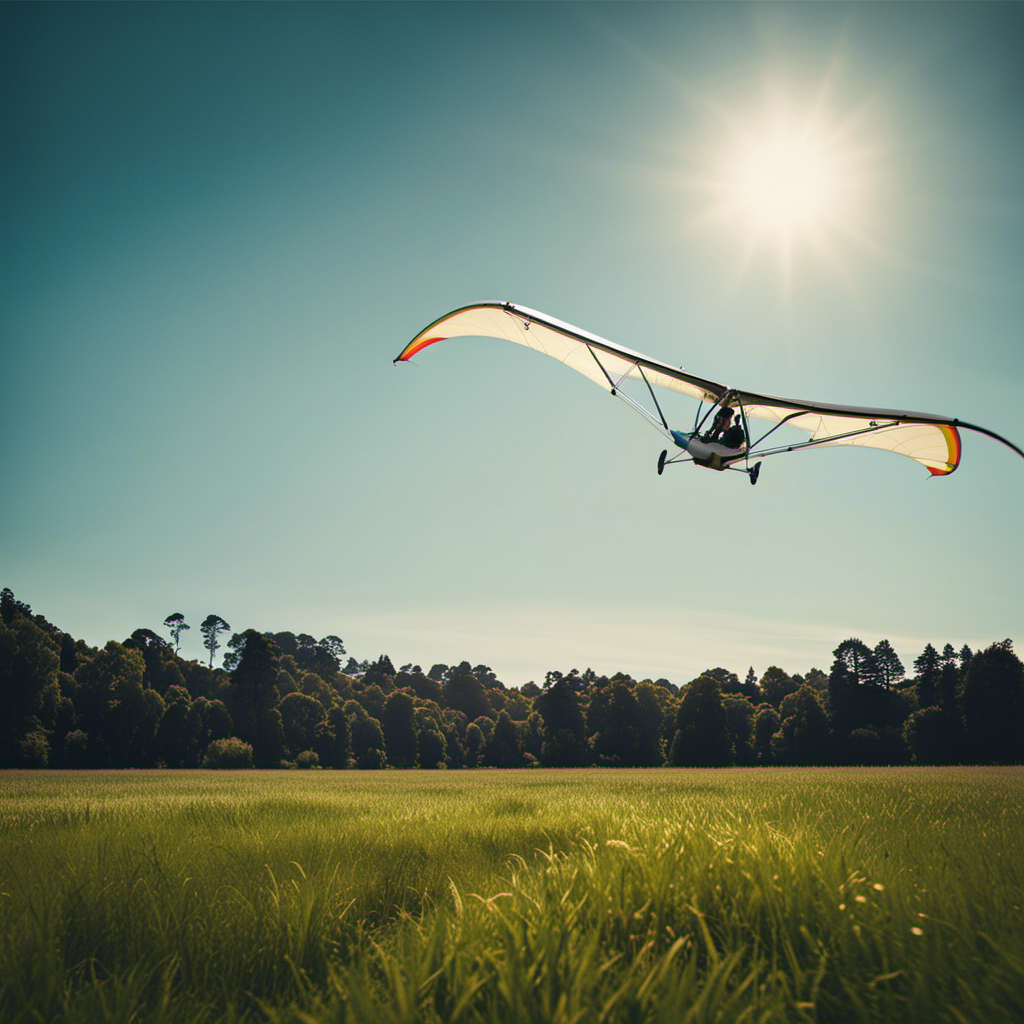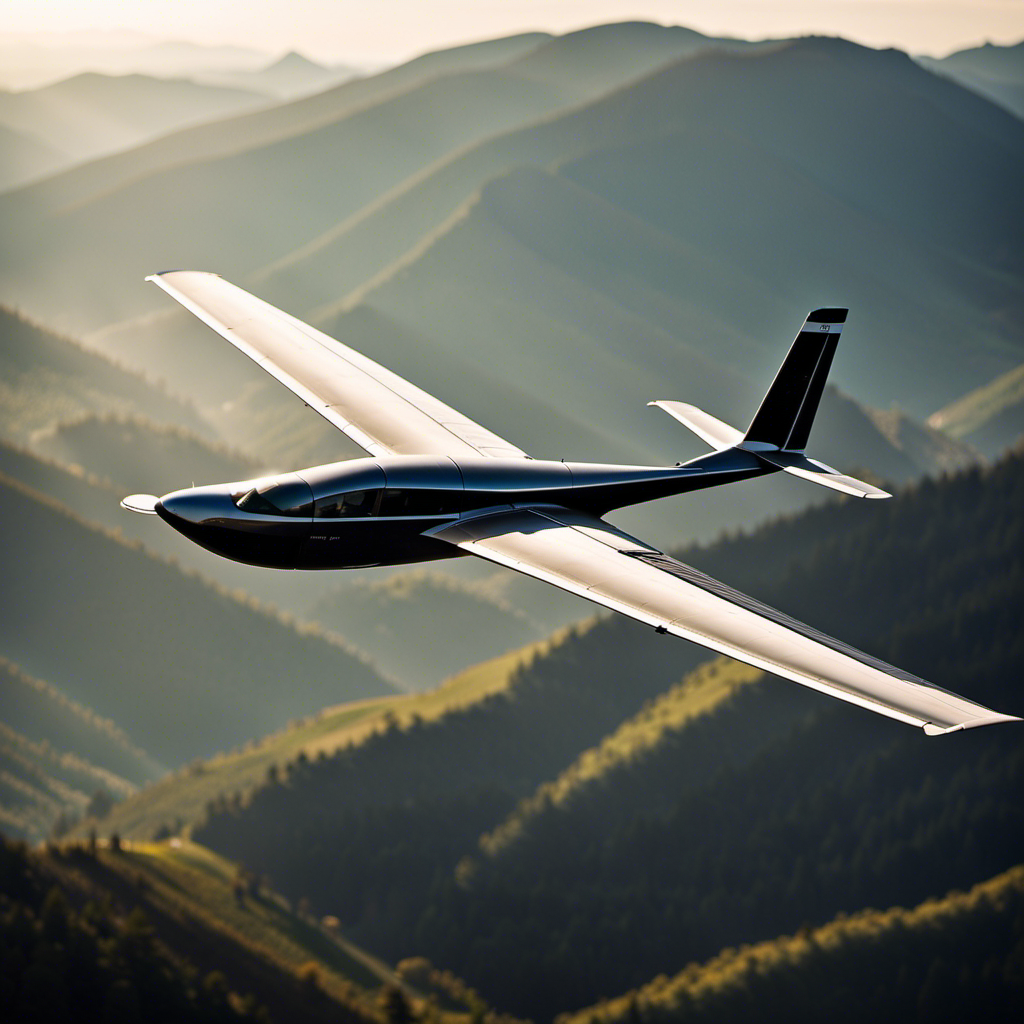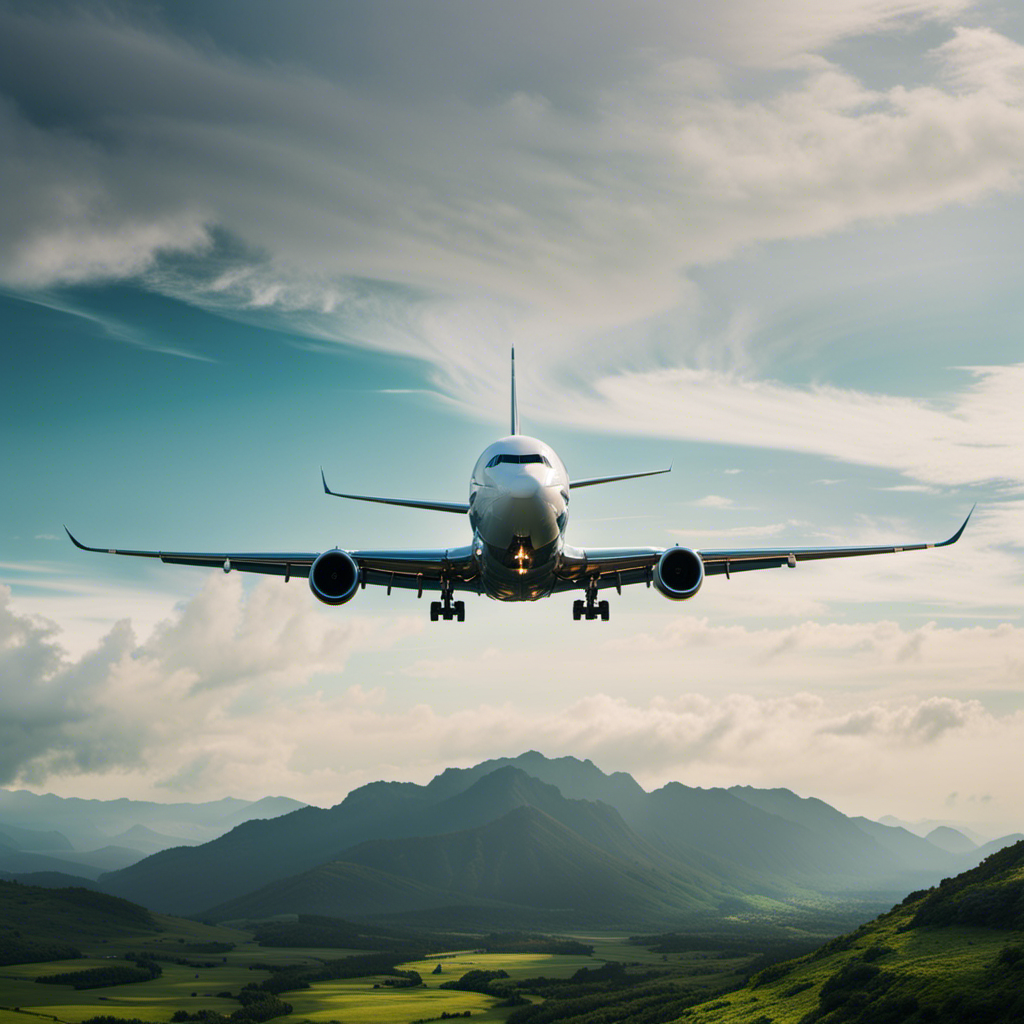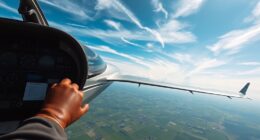I have always been fascinated by the feeling of soaring through the air, like a bird riding on air currents. And now, with a motorized hang glider, this dream can become a reality.
In this article, I will guide you through the process of launching a motorized hang glider, step by step. From understanding the basics to ensuring your safety, I will provide you with the technical knowledge and detailed instructions you need to experience the exhilaration of motorized hang gliding.
So, let’s dive in and explore this thrilling adventure together.
Key Takeaways
- Choosing the right launch site based on wind direction and speed.
- Performing pre-flight checks such as verifying fuel level, inspecting the propeller, testing controls, and checking instruments.
- Positioning oneself correctly in the harness and adjusting throttle control for takeoff.
- Executing a successful launch by focusing on a smooth and controlled run for sufficient speed.
Understand the Basics of Motorized Hang Gliding
To begin, it’s important to understand the basics of motorized hang gliding. Motorized hang gliding techniques involve the use of a lightweight aircraft with a motor attached to it, allowing for powered flight.
Safety precautions are vital in this exhilarating activity. Before taking off, it is crucial to ensure that the glider is in proper working condition, with the engine properly maintained and fueled. Additionally, pilots must be trained in the correct operation of the motorized hang glider, including understanding the throttle control, brakes, and emergency procedures. It is essential to always wear a helmet and other protective gear to minimize the risk of injury.
By familiarizing oneself with these motorized hang gliding techniques and safety precautions, pilots can confidently take to the skies.
Now, let’s move on to gathering the necessary equipment and gear.
Gather the Necessary Equipment and Gear
Make sure you have all the necessary equipment and gear for your flight.
Before taking to the skies in a motorized hang glider, it is essential to have the right equipment to ensure a safe and enjoyable experience. Here is an equipment list to consider:
- A sturdy hang glider frame
- A reliable engine with a propeller
- A harness for secure seating
- A helmet for head protection
- A reserve parachute in case of emergencies
Additionally, it is crucial to follow safety precautions such as checking the maintenance and condition of your equipment regularly, wearing appropriate clothing for weather conditions, and conducting thorough pre-flight inspections.
By gathering the necessary equipment and adhering to safety precautions, you will be well-prepared to embark on your motorized hang gliding adventure.
Now, let’s discuss how to choose the right launch site for your flight.
Choose the Right Launch Site
Choosing the right spot for takeoff is crucial when preparing for a motorized hang gliding adventure. To find the ideal launch angle, it is important to consider the wind direction and speed. A launch angle that is too steep can result in a sudden loss of altitude, while a shallow angle may cause the glider to stall.
Additionally, selecting the appropriate weather conditions is essential for a safe takeoff. Clear skies, calm winds, and stable atmospheric conditions are ideal for launching a motorized hang glider. These conditions ensure smooth airflow and reduce the risk of turbulence during takeoff.
Perform Pre-Flight Checks
Performing pre-flight checks is an essential step before embarking on a motorized hang gliding adventure. These checks ensure the safety of both the pilot and the aircraft. By meticulously inspecting various components, potential issues can be identified and addressed before they become a problem in the air. Here is a table outlining the key checks that should be performed:
| Component | Check |
|---|---|
| Engine | Verify fuel level and condition |
| Propeller | Inspect for damage and secure attachment |
| Controls | Test functionality and proper movement |
| Instruments | Check for accurate readings |
Each of these checks plays a crucial role in ensuring a successful flight. Once all the necessary checks have been completed, it is time to prepare for takeoff. This involves securing any loose items, adjusting the harness, and mentally preparing for the exhilarating experience ahead.
Prepare for Takeoff
Before taking off in a motorized hang glider, it is crucial to position yourself correctly to ensure a safe and successful flight. This involves aligning your body with the glider, adjusting the harness and straps to fit snugly, and maintaining a balanced stance.
Once properly positioned, the next step is to start the motor, ensuring that it is running smoothly and producing enough power for takeoff.
Lastly, it is important to ready the wing by checking the lines and canopy for any tangles or damage, ensuring that everything is in proper working order before launching into the air.
Position Yourself Correctly
Once you’ve ensured the hang glider is secure, make sure you’re positioned correctly for takeoff.
The correct body position is crucial for a successful launch. Sit comfortably in the harness, with your back straight and your feet resting on the footrests. Your weight distribution should be evenly balanced between the glider’s centerline.
Lean slightly forward to maintain proper control and stability during takeoff. Keep your hands on the control bar, ready to make any necessary adjustments.
Start the Motor
To start the motor, simply reach for the ignition switch and turn it on.
Once the engine is running, you will need to adjust the throttle control to achieve the desired power output. The throttle control is typically located on the handlebars or within easy reach of the pilot. It allows you to increase or decrease the engine’s RPM (revolutions per minute) and thus control the speed of the propeller.
By smoothly adjusting the throttle, you can ensure a steady and balanced acceleration. This is important for a successful launch as it helps maintain control and stability during takeoff.
Once the engine is running smoothly, you can then transition into the next step of readying the wing for flight.
Ready the Wing
After starting the motor, you should get the wing ready for flight. The first step is to position the wing correctly. Ensure that it is aligned with the wind, facing directly into it. This will allow for optimal lift and stability during the launch.
Once the wing is positioned, it is important to conduct a thorough inspection. Check the wing fabric for any signs of wear or damage. Look for any loose wires or cables that may need tightening. Inspect the control surfaces to ensure they are functioning properly. Pay close attention to the wingtips and leading edges, as they are susceptible to damage. By thoroughly inspecting the wing, you can identify and address any potential issues before takeoff.
Now that the wing is ready, it’s time to execute a successful launch.
Transition: With the wing fully prepared, the next step is to execute a successful launch.
Execute a Successful Launch
When executing a launch in a motorized hang glider, there are three key points to focus on:
-
Run and takeoff: It is crucial to have a smooth and controlled run, ensuring that the glider gains sufficient speed for takeoff.
-
Maintain control and stability: Once airborne, maintaining control and stability is paramount. The pilot should utilize the control surfaces and make necessary adjustments to counter any gusts or turbulence.
-
Ascend to the desired altitude: The pilot must ascend to the desired altitude by adjusting the throttle and pitch angle. It is important to carefully monitor airspeed and engine performance to ensure a safe and efficient climb.
These three points are essential for a successful launch in a motorized hang glider.
Run and Takeoff
As I run and takeoff, I must ensure that I maintain a steady speed to execute a successful launch. Here are the key takeoff techniques and running speed considerations:
-
Runway alignment: Position myself in the center of the runway to ensure a straight takeoff path.
-
Acceleration: Gradually increase my running speed, allowing the hang glider to generate lift.
-
Power transition: As I approach takeoff speed, transfer my weight from running to flying by leaning forward and pushing against the control bar.
-
Smooth lift-off: Once I reach the required speed, gently apply upward pressure on the control bar to smoothly lift off the ground.
By following these techniques and maintaining a steady running speed, I can ensure a controlled and stable takeoff.
Now, let’s transition into the next section about how to maintain control and stability during flight.
Maintain Control and Stability
To maintain control and stability during flight, it is important to consistently adjust the weight shift and control inputs.
Control techniques are crucial in overcoming the stability challenges faced during motorized hang glider flights.
By smoothly shifting your weight, you can influence the direction and pitch of the glider.
Additionally, control inputs through the control bar allow you to adjust the wing’s angle of attack and roll.
It is essential to maintain a balanced and coordinated control input to ensure stability throughout the flight.
By continuously monitoring and adjusting these inputs, you can counteract any external factors that may affect the stability of the glider.
With proper control techniques, you can confidently ascend to your desired altitude, ready to explore the skies.
Ascend to Desired Altitude
You can confidently adjust your weight shift and control inputs to ascend to your desired altitude. Ascending in a motorized hang glider requires mastering specific techniques and maintaining precise altitude control.
To start the ascent, increase the throttle gradually while simultaneously applying gentle back pressure on the control bar. This action will initiate a smooth climb. As you gain altitude, continue to adjust your weight shift and control inputs to maintain a steady ascent rate.
Be aware of the wind conditions and make subtle corrections to counteract any drift. Keep a close eye on your altimeter to ensure you reach your desired altitude.
Once you have reached your desired altitude, you can smoothly transition into the next section about monitoring and adjusting during flight.
Monitor and Adjust During Flight
During flight, it’s important to continuously monitor and make necessary adjustments to ensure a safe and smooth ride. To effectively monitor the motorized hang glider, I rely on various techniques.
Firstly, I keep a close eye on the instrument panel, which displays essential information such as airspeed, altitude, and engine parameters. Additionally, I constantly scan the surrounding airspace for other aircraft or potential obstacles.
As for adjusting techniques, I regularly fine-tune the throttle to maintain the desired speed and altitude. I also make use of the control surfaces, like the elevator and ailerons, to ensure proper maneuverability and stability.
By employing these monitoring and adjusting techniques, I can promptly respond to any changes in flight conditions and maintain a controlled and comfortable flight.
Now, let’s delve into the next phase: planning for landing.
Plan for Landing
When preparing for landing, it’s crucial to assess the wind direction and speed to determine the most suitable approach. Landing techniques are essential to ensure a safe and controlled touchdown.
The approach angle should be adjusted according to the wind, with a shallower angle for headwinds and a steeper angle for tailwinds. Maintaining a steady descent rate is crucial to avoid a hard landing.
In case of an emergency, it’s important to have a thorough understanding of the emergency procedures, such as executing a go-around or aborting the landing altogether. These procedures should be practiced regularly to ensure quick and effective responses in critical situations.
Practice Safety Measures
When it comes to practicing safety measures in motorized hang gliding, it is crucial to follow local regulations and guidelines. This ensures that you are aware of any specific requirements or restrictions in your area, promoting a safe and responsible flying experience.
Additionally, maintaining regular maintenance of your equipment is essential for optimal performance and safety. Regular inspections and servicing help identify and address any potential issues before they become major problems.
Lastly, continuously improving your skills and knowledge is vital in enhancing your flying abilities and keeping up with the latest safety practices and techniques. Ongoing training and education contribute to a safer and more enjoyable motorized hang gliding experience.
Follow Local Regulations and Guidelines
Make sure you follow the local regulations and guidelines when launching a motorized hang glider. It is crucial to prioritize safety and adhere to the rules set by the authorities.
Here are the key points to consider:
-
Local regulations:
-
Check with your local aviation authority for any specific regulations pertaining to motorized hang gliders in your area.
-
Familiarize yourself with the airspace restrictions and obtain necessary permits or licenses.
-
Safety guidelines:
-
Complete a comprehensive pre-flight checklist to ensure your hang glider is in optimal condition.
-
Wear appropriate safety gear, including a helmet and a properly fitted harness.
By adhering to the local regulations and following safety guidelines, you can ensure a smooth and secure launch.
Now, let’s move on to the next section, where we discuss the importance of maintaining regular maintenance of equipment.
Maintain Regular Maintenance of Equipment
To ensure the longevity and proper functioning of your equipment, it’s essential to regularly maintain your motorized hang glider. Regular maintenance and equipment upkeep are crucial for safety and performance. Neglecting these tasks can lead to malfunctions or even accidents during flights. The table below outlines the key components that require regular attention and the recommended maintenance intervals.
| Component | Maintenance Interval |
|---|---|
| Engine | Every 25 hours |
| Propeller | Every 50 hours |
| Fuel System | Every 100 hours |
| Control Cables | Every 50 hours |
| Wing Fabric | Every 6 months |
Continuously Improve Skills and Knowledge
After ensuring the regular maintenance of my motorized hang glider, I understand the importance of continuously improving my skills and expanding my knowledge in order to enhance my overall flying experience.
Improving technique is essential for a successful launch and a smooth flight. By practicing proper body positioning, weight shifting, and control inputs, I can achieve better control and stability in the air.
Additionally, expanding my knowledge of aerodynamics, weather patterns, and navigation techniques will enable me to make informed decisions during my flights, ensuring my safety and the safety of others.
Enjoy the Thrill of Motorized Hang Gliding
Experience the exhilarating thrill of motorized hang gliding as you soar through the sky. Motorized hang gliding combines the freedom of flying with the power of an engine, allowing you to explore the skies in a whole new way. To fully enjoy this adventure, it is important to master the motorized hang gliding techniques and choose the right weather conditions for your flights.
When it comes to launching a motorized hang glider, there are several key steps to follow. First, ensure that the glider is properly set up and all equipment is in good working condition. Next, position yourself in the hang glider and secure all safety harnesses. Once you are ready, start the engine and gradually increase the throttle to gain altitude. As the glider gains speed, apply gentle pressure on the control bar to lift off the ground.
Table:
| Emotion | Description |
|---|---|
| Excitement | Heart racing, adrenaline |
| Freedom | Sense of liberation |
| Adventure | Thrilling exploration |
| Awe | Wonder and astonishment |
| Joy | Pure happiness |
Frequently Asked Questions
How much does a motorized hang glider cost?
The cost of a motorized hang glider can vary depending on the brand, model, and additional features. On average, prices range from $10,000 to $30,000. However, it’s important to consider the long-term maintenance costs as well.
Can I use a regular hang glider for motorized hang gliding?
No, a regular hang glider cannot be used for motorized hang gliding. The advantages of motorized hang gliding include increased range and the ability to fly in varying weather conditions. Safety considerations include proper training and maintenance of the motorized hang glider.
What is the maximum weight limit for a motorized hang glider?
The maximum weight limit for a motorized hang glider is determined by safety regulations. It is crucial to adhere to these limits to ensure the safe operation of the aircraft.
Are there any age restrictions for motorized hang gliding?
Age restrictions for motorized hang gliding vary by country, but in the US, you must be at least 16 years old to operate one. Safety precautions include proper training, adherence to regulations, and wearing appropriate safety gear.
Do I need a license or certification to operate a motorized hang glider?
I need a license or certification to operate a motorized hang glider. License requirements vary by country and may include passing written and practical exams. Safety regulations must also be followed to ensure a safe and successful flight.
Conclusion
In conclusion, motorized hang gliding is an exhilarating and thrilling experience that requires careful planning and preparation. By understanding the basics, gathering the necessary equipment, and choosing the right launch site, you can ensure a successful flight.
Performing pre-flight checks and monitoring adjustments during flight are crucial for safety. Remember to practice safety measures and always be prepared for landing.
So strap on your helmet, hop into the cockpit, and get ready to soar through the skies like a modern-day Icarus.
With a heart that soars as high as the skies, Aria, affectionately known as “Skylark,” is the driving force behind Soaring Skyways. Her journey into the gliding world began as a young dreamer gazing up at the soaring birds, yearning to experience the weightlessness and freedom they embodied. With years of experience both in the cockpit and behind the scenes, Aria’s commitment to the gliding community is unwavering.










